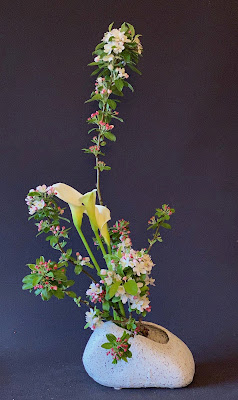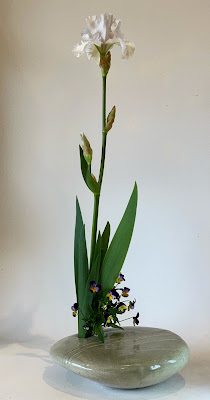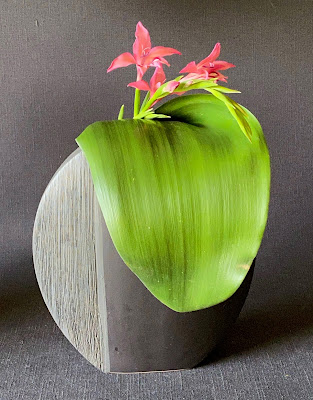Hello all,
Yes, it is possible to have too much material. A number of my hippeastrums flowered at the same time, challenging me to make a suitable arrangement. With such large, bold flowers, I had to keep to a simple design. Luckily, I have this 65cm, metal trough, which fit the bill perfectly. I, also, have a large number of cottage gladioli, which have flowered all at once, so they, too, were put to use. The black wisteria vine added line and asymmetry.
I found tucked under a large willow branch this stem of mahonia, which caught my attention by the bright orange colour on the tips of some of the leaves. I don't know why this happens because mahonia is an evergreen and does not change colour. As I looked at it more closely, I noticed the soft, russet coloured new growth and delicate, blue berries. I removed many of the leaves, leaving this pin wheel shape and added the strelitzia, which picked up the orange colour of the leaves as well as the blue berries. These subtleties are mostly lost in the photograph.
 |
| The mahonia 'pinwheel' measures about 1 metre in diameter |
I took mum to the radiologist last week and when I drove into the car park I was struck by the vibrant red coloured flowers of quite a large
callistemon. As we were leaving I asked for permission to cut some and was told to help myself. The problem was that other drivers going in and out of the car park didn't know that I had permission. When people walked past I felt obliged to say that I had permission. It's amazing how much guilt you can feel even when you're not guilty.
I use this large, ceramic vase quite infrequently (mostly at Christmas) because it is so bold and dominates an arrangement but I thought it worked well enough here teamed with masses of viburnum opulus.
I found some more of these strange looking flowers - Arum italicum - Pictum. Last time I used one, it had drooped over itself in one day. This time they lasted for three days, probably because I cut them earlier, almost in bud.
Every October, for a number of years now, these delightful flowers come out of the ground with their hooded spathes and long tongue-like spadix. The leaves are compound with three leaflets. I have been unsuccessful in my efforts to find out their name except that they belong to the Araceae family. I was delighted when Lucy told me yesterday that they are called pinellia tripartita. I'm very happy to concede that Lucy is much better at navigating the internet that me.
This wall arrangement was created solely to showcase the wisteria,which needed the height for the racemes to be hanging down.
 |
| Wisteria, strelitzia reginae leaf and cottage gladioli |
A couple of interesting things happening in our garden.
Our gymea lily,
doryanthes palmeri, has four gigantic flowers. For those who are unfamiliar with this plant, it is difficult to guage its size. The flower stalks, called scapes, are about 2.5 metres tall with very heavy, large flower heads comprising of many individual flowers. Because of this weight, the stems tend to droop. I should explain that ours is a clump of many rosettes. Once a rosette flowers, it dies but produces many new rosettes in its place. It is endemic to a very small part of New South Wales and Queensland and the flower spikes and roots were a food source for indigenous Australians. Our clump has pride of place in the front garden and I have noticed a number of people stopping to photograph it.

The other plant of interest this time of year is our walnut tree, which is in flower. It produces large, pendulous, male flowers that hang down below the stem and tiny little female ones that sit above the stem. I noticed an abundance of bees amongst the branches of the tree. I hope that means we'll get some decent walnuts.
 |
| Male flowers |
 |
| Female flowers |
By for now,
Emily










































